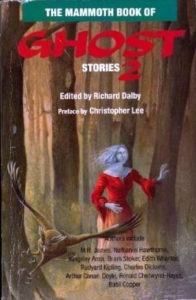
Well, it is October…
I picked up The Mammoth Book of Ghost Stories 2, from Magus Books in Seattle when I was attending Graduate School. Magus Books is an archetypal used bookstore that one can sometimes find near Universities: in an old brick building covered with ivy and loaded down to the gills with all manner of volumes. It wasn’t the first book of supernatural tales I had bought. As a teenager, I read much of Stephen King’s output and from there onto Clive Barker. In fact, the story I had submitted to the Creative Writing Department at the University of Washington was a ghost story, although not the wet, dangerous work of King or Barker.
I still have The Mammoth Book of Ghost Stories 2, because in there was my first contact with M.R. James.
“Rats” finds its homage in Collecting Shadows right in the very first story, “The Strand” which was a pastiche, homage, (whatever you want to call it) of James’s mysterious story. There is enough written about James that I don’t need to really add much, save for I was enthralled by his particular formula for creating a weird tale. I’m not even really sure you can always call his stories ghost stories. Some of my favorites, like “Oh’ whistle, and I’ll come to you my lad,” “Canon Alberich’s Scrapbook,” and “The Treasure of Abbott Thomas” don’t really have a “human-sourced” supernatural being. The antagonists are summoned from an inhuman place, although unlike H.P. Lovecraft’s cosmic monstrosities, they seem to be content to occupy a small place in our world. But the monsters aren’t the point. What charms about James is how he slowly builds up the tension.
The best ghost stories of the 19th and early 20th Centuries are master-classes in fiction writing. Setting, plot, a bit of character and point of view are all carefully considered and presented. In terms of setting, there is a certain aspect of mundanity in James’s stories that lures you in. It’s part of the overall plan: create a plain stage and dress it with items that are (or were, in many cases) familiar. It’s the place we all fear: our “ordinary” world becomes a place where the uncanny can irrupt into. Quite often the narrative focus is a character who was not involved or intimate with the terrible back-story of the ghost. Like the reader, they “stumble into this affair,” and so we are carried along with them to the resolution.
This is but one formula. The great thing about ghost stories is that they are endlessly malleable. They are a mode of fiction that can easily overlay other genre forms: science fiction, mystery, Southern Gothic, historical fiction and even comedy: Oscar Wilde’s “The Canterville Ghost” and Mark Twain’s deeply postmodern “A Ghost Story” are canonical examples of funny ghost stories. I’ve read somewhere that Ulysses is a ghost story, because the entire novel is haunted by the absence of Rudy, Leopold Bloom’s dead son. Beloved, by Toni Morrison is a novel length ghost story that freights the awful weight of racism and slavery. If you care to expand the definition, many novels naturally become ghost stories because the people the author was writing about are often dead, but they ‘haunt’ us still.
And so the first stories in Collecting Shadows are what we would call ghost stories: from “The Strand,” to the living ghosts in “The Ladies of Keldmere” to the hideously pitiable ghosts of “The Church of the Hidden Children.”
Many readers want to know that which is hidden. A ghost is a tantalizing secret, one that we must discover, at times to our own peril, and the writer is the first person who must go down that shadowy path. Given this natural allure, I don’t think ghost stories will be going anywhere soon.
If you want to check out an old-school HTML page dedicated to M.R. James, check out Ghosts and Scholars. A true labor of love in honor of the master.
The above cover image is from the Carroll & Graf Publishers, ISBN 978-0881847017 Art by Peter Kettle, 1991.
#ghoststories #richarddalby #mrjames #collectingshadows #fiction #inspirations #magusbooks
